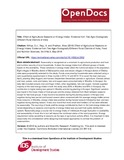| dc.contributor.author | Nithya, D.J. | |
| dc.contributor.author | Raju, S. | |
| dc.contributor.author | Pradhan, Aliza | |
| dc.coverage.spatial | India | en |
| dc.date.accessioned | 2018-06-05T14:26:44Z | |
| dc.date.available | 2018-06-05T14:26:44Z | |
| dc.date.issued | 2018 | |
| dc.identifier.citation | Nithya, D.J., Raju, S. and Pradhan, A. (2018) Effect of Agricultural Seasons on Energy Intake: Evidence from Two Agro-Ecologically Different Rural Districts of India. Food and Nutrition Sciences, 9, 542 -555. | en |
| dc.identifier.issn | 2157-944X | |
| dc.identifier.uri | https://opendocs.ids.ac.uk/opendocs/handle/20.500.12413/13810 | |
| dc.description.abstract | Seasonality is recognised as a constraint to agricultural production and food and nutrition security of rural households. It alters the energy intake from different groups of foods based on the availability. These variations in energy intake affect the nutritional status of the population. Eight villages in Wardha district of Maharashtra state and eleven villages in Koraput district of Odisha state were purposefully selected for the study. Foods consumed by households were collected using a semi-quantitative questionnaire in three rounds in 2013-14 and 2014-15 to cover the lean (January-April), planting (May-August) and harvest (September-December) periods in agriculture. Cereals (wheat and rice), pulses, roots and tubers, fats and sugars were consumed daily in Wardha. In Koraput, the daily diet included cereals (rice and finger millet), other vegetables, fats and sugars. Cereals supplied majority of the total energy intake in both the study area (63% in Wardha and 85% in Koraput); the contribution is higher during lean period in Wardha and during planting in Koraput. Significant variation was found in the mean intake of food groups and the energy obtained from them between seasons except for few food groups. It was found to be positive during the planting season in Koraput and negative during lean period and harvest season when compared with the average energy intake across three seasons; in Wardha, energy intake was positive during harvest season followed by lean and was negative during planting season. It was also found that most small land holders (<2 ha) were affected by seasonality. The sourcing of foods and the energy contributed by them to the total energy intake also varied depending on seasons and majority of energy intake was sourced from public distribution system. Seasonality plays a crucial role in energy intake of individuals through fluctuation in availability and accessibility of food; this in turn will impact the nutritional status of the rural population. Energy requirement varies according to seasons as the type of agriculture activity differs. It is important to take seasonality into consideration while designing food-based approaches to combat the problem of undernutrition. | en |
| dc.language.iso | en | en |
| dc.publisher | Scientific Research Publishing | en |
| dc.rights | Copyright © 2018 by authors and Scientific Research Publishing Inc.This work is licensed under the Creative Commons Attribution International License (CC BY 4.0) | en |
| dc.rights.uri | http://creativecommons.org/licenses/by/4.0/ | en |
| dc.subject | Agriculture | en |
| dc.title | Effect of Agricultural Seasons on Energy Intake: Evidence from Two Agro-Ecologically Different Rural Districts of India | en |
| dc.rights.holder | © 2018 by authors and Scientific Research Publishing Inc. | en |
| dc.identifier.externaluri | http://www.scirp.org/Journal/PaperInformation.aspx?PaperID=84676 | en |
| dc.identifier.doi | 10.4236/fns.2018.95041 | |
| rioxxterms.funder | Default funder | en |
| rioxxterms.identifier.project | Default project | en |
| rioxxterms.version | NA | en |
| rioxxterms.versionofrecord | https://doi.org/10.4236/fns.2018.95041 | en |
| rioxxterms.funder.project | 9ce4e4dc-26e9-4d78-96e9-15e4dcac0642 | en |


